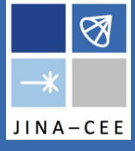Speaker
Kaley Brauer
(Massachusetts Institute of Technology)
Description
We present our stellar halo evolution model for Milky Way-mass galaxies using a set of high-resolution zoom-in cosmological simulations from the *CaterPillar* suite, the largest suite of its kind. The extended outskirts of a galaxy (the stellar halo) contain mainly old, metal-poor stars that originated in the many dwarf satellites that were accreted by the host galaxy. Stellar halos thus contain critical information about a galaxy's evolutionary history, but we currently lack a detailed theoretical model to closely connect observations to the processes driving galaxy formation. To model the large scale evolution of the halos, we have created an initial stellar halo model to study the mass spectrum of destroyed satellite galaxies and the metallicity distribution of accreted stars. Empirical models such as mass-metallicity relations and abundance matching are used to assign metallicities and stellar masses.
This work is a first step towards creating a detailed theoretical model of stellar halo evolution. With such a model, we will be able to interpret stellar halo data from the GHOSTS survey, Gaia, and spectroscopic surveys such as APOGEE to obtain a deeper understanding of how our galaxy, and the galaxies around us, formed.
Primary authors
Alexander Ji
(Carnegie Observatories)
Prof.
Anna Frebel
(Massachusetts Institute of Technology)
Kaley Brauer
(Massachusetts Institute of Technology)
